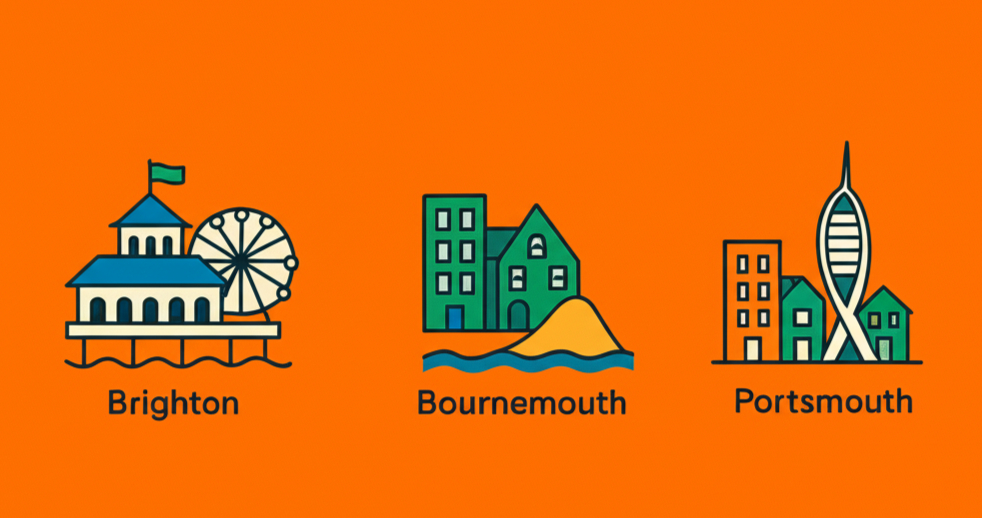
If you’re considering property investments in the UK, you’ve likely asked the classic question: Should you invest in London or the North of England? Both regions offer exciting opportunities. But which one truly aligns with your goals and budget? Let’s break it down and explore the key differences, so you can invest with clarity. Over the past few years, the North of England has emerged as a powerful alternative. Cities like Leeds, Liverpool, and Manchester offer more affordable entry points, solid rental returns, and are backed by large-scale regeneration initiatives like HS2 and the Northern Powerhouse.
While capital growth may be slower or more variable compared to London, the ability to invest at a lower cost and benefit from rising demand and transformation makes the North especially appealing. particularly for those looking to scale quickly or diversify their portfolios. As the UK property market evolves, many investors are beginning to rethink the old London-centric approach. Balancing the prestige and stability of the capital with the affordability and yield potential of the North.
Why Invest in London Property?
Strengths: What Makes London a Strong Investment Hub?
- Global City Advantage: The stability of capital in London is guaranteed in the long-term perspective. It is an economy that appeals to international investors, students, and professionals throughout the year.
- Consistent Demand: The number of people in London keeps increasing, and this poses a consistent demand for sales and rental properties.
- Capital Appreciation: London’s prime and emerging areas have long proved to provide one of the best capital increases in the UK.
- Resilient Rental Market: The tenant demand is always strong, whether it is students or executives, boroughs near transport or the best universities are particularly sought-after.
Weaknesses: What Challenges Do London Investors Face?
- High Entry Costs: The national average is almost half the price paid in an average London house, and this makes it more difficult to find first-time investors or those who would want to scale.
- Planning Complexity: It can be overwhelming in London with its borough-by-borough planning policies, particularly with HMO and serviced accommodation.
- Intense Competition: Property investment in London has been very competitive, and this restricts the ability to negotiate as well as drives down the yields.
Opportunities: Where Can You Still Find Value in London?
- Regeneration Zones: Fixed locations such as Thamesmead, Barking Riverside, and Old Oak Common are places where billions of pounds are being invested, which is perfect with regard to long-term appreciation.
- Luxury-to-HMO Conversions: The owners of high-end properties that are no longer appropriate to the luxury buyer market have the opportunity to convert them into co-living HMO to raise ROI. (learn how)
- Co-Living & Later-Living Trends: This type of asset is rapidly expanding in London, and it is being promoted by the council, more young professionals and downsizers are showing interest in these properties.
Threats: What Should Investors Watch Out For?
- Political & Regulatory Risk: Future investment returns may be damaged because there are potential rent caps, increases in property taxes or a ban on foreign buyers.
- Over-Saturation in Prime Zones: Certain postcodes in central London are exposed to the threat of oversupply in terms of luxury flats and short-term leases.
Why Consider Property Investment in the North of England?
Investment in the North of England is bearing an irresistible appeal to shrewd investors interested in generating yields and expanding their portfolio without its expensive price tag that is synonymous with investing within the capital. Manchester, Liverpool, Leeds, and Sheffield are all during major change, with mega-regeneration schemes, rising local economies, and new initiatives to connect the cities better, such as HS2. Naturally, the North has access at a lower entry amount, so new and even experienced investors may get involved, and the rental returns in numerous postcodes tend to do better than is in London, especially regarding HMO and co-living kinds.
It is also beneficial in the sense that this area has friendly local councils, which are, in many instances, willing to support projects that coincide with the objectives of regeneration or affordable housing. The need for well-designed rental accommodation is rapidly increasing, with the student population being very high and the post-graduates preferring to settle in cities in this region. In addition to this, the Northern Powerhouse initiative continues to reassure investors, especially as government housing and planning data support rising demand in northern cities.
The slow pace of capital appreciation compared to London notwithstanding, the high nature of the yield potential and the prospects of value-add conversions make the North a gateway investment destination, especially among This strategy is also being used by investors exploring options beyond London like the South Coast property investment opportunities in Brighton, Portsmouth, and Bournemouth. Achieve sustainable portfolio growth. Where there is a suitable planning and design consultant/firm, like HMO Architects, investment in the North also presents the best risk versus reward situation, particularly to the re-developers intending to capitalize on high returns through thoughtful design applications on their properties and astute selection of location.
Strengths: Why Invest in Manchester, Liverpool, and Leeds?
- Lower Entry Prices: It is also possible to purchase several investment properties in places such as Liverpool or Bradford, at the cost of a single flat in London.
- Higher Yields: They can deliver at least 8 percent in such areas as Salford, Toxteth, and Ancoats, and especially in the well-considered HMO.
- Economic Growth: The tech boom in Manchester and the expansion of the port in Liverpool are signs of the continuous creation of jobs and city development.
- Council Support: Numerous councils in the North are engaged in furthering regeneration and conversion, as well as affordable housing schemes.
Weaknesses: What Are the Risks of Investing Up North?
- Slower Capital Appreciation: There is a robust performance of yields. However, long-term capital may not be at par with London in other aspects.
- Pockets of Low Demand: Demand for tenants may be street-to-street. A comprehensive amount of local knowledge is important.
- Fragmented Planning Rules: The situation is different in the north, where councils vary considerably in policy, with some welcoming HMO, and others imposing tight Article 4 controls.
Opportunities: What Makes the North Attractive Right Now?
- HS2 & Northern Powerhouse: The demand for housing is rising as new commuter belts are being opened by transport upgrades.
- City-Centre Regeneration: Areas such as Leeds South Bank and Liverpool Knowledge Quarter are becoming urban hotspots.
- Student-to-Professional Transitions: There is increasing retention of many graduates after their studies, and thus a continued need for professional HMO.
Threats: What Could Impact Northern Investments?
- Market Volatility: Other towns are susceptible to economic shocks or changes to availability or demand by students.
- Council Policy Changes: Future developments can be constrained by the sudden introduction of Article 4 zones or by increasing the licensing criteria.
- Risk of Oversupply: In such places as central Manchester, there are a lot of new builds that could flood the market to an extent where the demand cannot be met.
Property Investment in London vs the North – SWOT Summary
| Factor | London | North of England |
| Strengths | Capital growth, international demand, transport access | Low entry cost, high yields, regeneration support |
| Weaknesses | Expensive entry, planning complexity, intense competition | Uneven demand, slower capital growth, fragmented policies |
| Opportunities | Regeneration, co-living trends, luxury conversions | HS2 corridor, city-centre renewal, graduate rental markets |
| Threats | Political risk, foreign buyer restrictions, over-saturation | Local policy shifts, market volatility, development oversupply |
How HMO Architects Can Help You Maximise ROI
Whether it is a buy in Manchester of the first HMO or the conversion of a townhouse in London to a co living accommodation or whether it is our involvement or whether you are looking at the possibilities of an investment in serviced accommodation or looking at converting a property into an HMO, we are there to assist through it all.
We’ll help you:
- De-risk your investment through expert planning, feasibility studies, and design audits.
- Navigate planning permissions across both London and Northern councils. Our complete HMO planning permission guide Beaks it down by region.
- Optimise layouts for rental income, tenant satisfaction, and long-term compliance.
- Streamline project delivery—from design to build to handover.
We don’t just design buildings – we help build your investment future.
Book a Discovery Call to speak to our team about your next project.
Related Guides and Resources
Final Thoughts: Where Should You Invest – London or the North?
London property investment is one of the good long-term incentives in the event you are interested in high-powered capital growth and can accept complexity. However, when you think of high levels of rental returns, rapid growth, and less capital outlay initially, then the North of England, these days north of Manchester down to Liverpool, has unrivaled potential in 2025
In any investment beyond one, success will be driven by intelligent design, regulation comprehension, and strategizing. That is where we enter the picture.
Let’s turn your vision into a high-performing investment.
Book your strategy session today and let’s unlock the full potential of your property portfolio.




